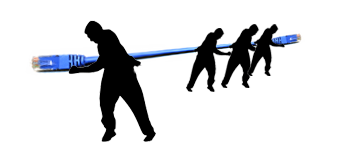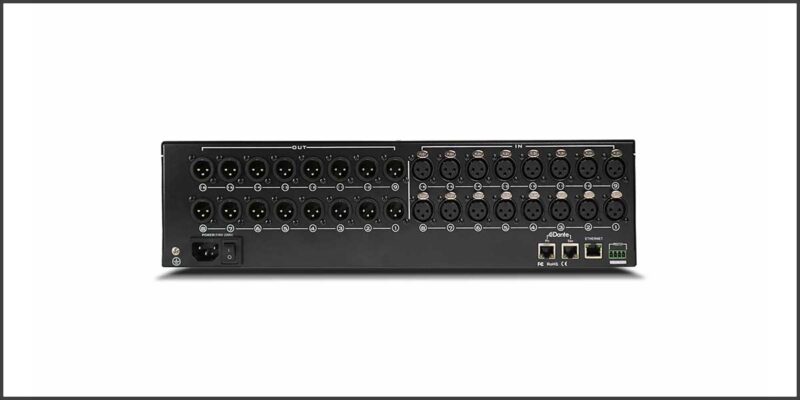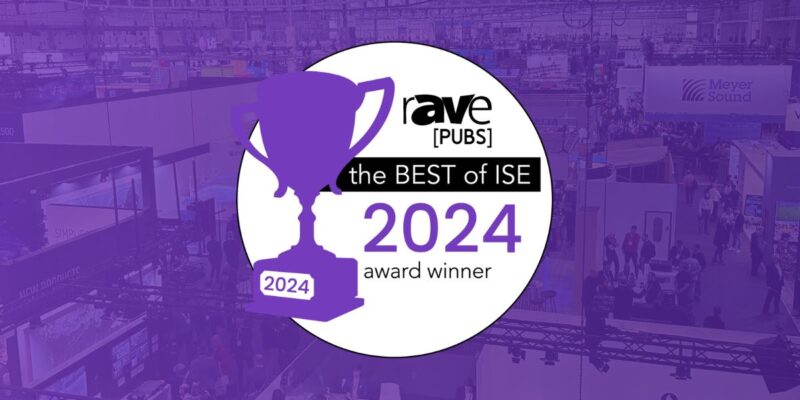InfoComm: Networked Audio for Live Events
Written by Dan Daley
This column was reprinted with permission from InfoComm International and originally appeared here.
 Networked digital audio has become a goal for many live-event producers, with the Holy Grail being an analog-to-digital conversion that takes place at the stage box, with the audio signal staying digital until it hits an amplifier on the way to a speaker. And with more audio network choices available today, achieving digital nirvana is more possible — and affordable — than ever before.
Networked digital audio has become a goal for many live-event producers, with the Holy Grail being an analog-to-digital conversion that takes place at the stage box, with the audio signal staying digital until it hits an amplifier on the way to a speaker. And with more audio network choices available today, achieving digital nirvana is more possible — and affordable — than ever before.
It’s been a long time coming. CobraNet, the first successful digital audio networking protocol, developed by Peak Audio in the mid-1990s, had a shot at becoming the industry standard. But although its uptake by the professional audio industry was relatively rapid, it wasn’t fast enough to outpace a host of other companies that thought they had an equally good chance at developing a widely-accepted digital audio networking solution themselves. By the turn of the century, there were nearly a dozen proprietary networking protocols on the market, each vying for broad acceptance by various sectors of audio. And they were increasingly targeting live sound.
A Fractured Landscape
Digital audio networking is a fast-changing landscape, but a consensus among several live-sound specialists suggests that Audinate’s Dante and EtherSound have become the leading formats for live events in the U.S., particularly for music shows and concerts. Dante benefits from its technical advances, including the ability to pass through network switches and routers, native gigabit support, high channel count (up to 1,024 per link), and automatic configurability, as well as an assertive marketing effort that has over 50 licensees that have integrated Dante into their products, including Yamaha, Allen & Heath, Bosch, Electro-Voice and Peavey.
Activity is coming along other avenues, as well. For instance, German audio systems maker Stagetec is positioning its Nexus router and digital consoles, which are used in a networking mode for broadcast and theatrical applications, for more live-sound events with the addition of interfaces for Dante and other formats.
French-owned EtherSound enjoys widespread acceptance in part because of its relatively high channel count and because it has had an extended relationship with Yamaha, which has maintained a consistently large market share in the live sound market, particularly in the digital console sector. EtherSound’s design is compliant with the IEEE 802.3 Ethernet standard (both ES-100 and ES-Giga, though not simultaneously) and its low and predictable latency is a plus. What’s not a plus, some say, is its somewhat limited topology: It is only able to distribute audio and control data one way. It supports two-way communications only when wired in a daisy-chain topology, but that’s usually good enough for most of the point-to-point music applications for which it’s used.
None of this is to say live events pros will choose between Dante and EtherSound for network audio. The market has grown crowded in the last several years with more new entries. Major ones include:
- Optocore, based in Germany and capable of 512 audio channels at 48 kHz and 24 nodes in a ring topology with low latency.
- RockNet, from Riedel, offers up to 160 channels (on RockNet 300; the RockNet 100 version has up to 80 channels) and 48 kHz or 96 kHz (RockNet 300) sample-rate operation. Up to 99 devices can ride on one network and audio can use a redundant CAT-5 network interface.
- Aviom’s Pro64 audio network, running the A-Net protocol, now includes a modular and field-configurable AllFrame system, which uses a single CAT-5e or fiber connection between locations to send both power and audio.
- Another German company, ALC NetworkX, is promoting Ravenna, an advanced audio-over-IP Layer-3 network technology. German mixer and router manufacturer Lawo, which is supporting Ravenna — as is Telos’ Livewire network — reports that its clients have been successful using basic MADI and digital routers to create digital audio networks for live events.
More of the Same, but Differentiation Exists
As digital audio networks have proliferated, their basic capabilities — such as 96-kHz sampling rates, ubiquitous RJ-45 connectors, and CAT-5 as the main cabling — have become more common across brands. Most systems have also implemented more intuitive automation of system setup, which, along with dropping prices, has helped the digital audio network category broaden its user base.
Usable distances have also increased, from up to 500 feet over CAT-5e cable, to nearly a mile on multimode fiber, to several kilometers over single-mode fiber.
“All of the systems on the market today are pretty robust,” says Steve Seable, networking manager for Yamaha, citing parameters such as latency, where there is increasingly less differentiation among systems and which has more to do with the amount of A-to-D conversion than any inherent limits in a system. “Each network has a few specific features that make it more suitable to particular applications.”
The same goes for audio networking solutions. For example, Lab.gruppen’s integration of a 4-in/8-out Dante interface on its LM-44 Lake processing system is designed specifically to high-end music systems users. Moreover, roadworthiness is quickly becoming a key differentiator of digital audio networks, as the concert-touring market becomes an larger source of revenue for the music industry.
“Sound reinforcement companies are making more of an effort these days when it comes to choosing the most reliable and roadworthy network products,” says Seable. “CAT-5 cable is cheap and good for installation projects, but for touring shows, you need a better cable that can be constantly rolled up and rolled out for use in touring. Several cable manufacturers have increased the number of available ruggedized — or armored — Ethernet choices, making Ethernet a reliable format for the road.”
Topology also remains a differentiator. Most systems run as rings that can be daisy-chained together. Their chief advantage is simplicity of set up and operation, which has found favor among music producers. Dante, however, uses a switch-based star-type configuration, which offers a higher degree of redundancy and appeals to live projects that need a high degree of control data, along with audio.
Industry observers expect more brands and systems to join the fray in the near future. However, proprietary protocols, which are common when new technologies enter a market, will need to give way to more interoperability for adoption to move forward. Jack Kelly, president of Group One, which distributes the Digico line of digital audio mixers, says systems user are going to demand more commonality of operation in the future.
“The Holy Grail is that all devices from all manufacturers talk the same language so that everything works together, like the Internet,” he explains. “Today you have to build a digital control surface mixer [i.e., audio mixer] that has all the processing that connects via a protocol such as MADI over copper or optical cabling, to a rack with actual XLR I/O, as well as every other format, such as ADAT, AES, Dante, Aviom and so on.”
Audio Video Bridging (AVB) is regarded by many as an open-source solution for just what Kelly describes. An AVB network implements a set of protocols based on the IEEE 802.1 standard and offers functionality including precise synchronization and shaping of streaming data traffic and automatic device identification.
However, AVB’s roll-out has been measured and there are still interface issues to resolve. Plus, AVB still requires investment in hardware, such as AVB-compliant switches, which presents significant cost for large systems providers, including Clair Global, the biggest live-sound systems provider in the U.S.
Shaun Clair, engineering coordinator for Clair Global explains, “All of our amp racks are fitted with a pair of gigabit switches, which allows each rack to be a node on our Dante networks. The transition path to AVB compliance will require all of these switches to be replaced. Capital-intensive decisions like this make the migration to new technologies tricky.”
A Leader Emerging?
Dante’s quick rise in the market was evident at the InfoComm 2012 Show in June, when several companies, including Shure and Lectrosonics announced Dante interfaces. Even Harman Professional, which was one AVB’s early champions, announced support for Dante.
Michael MacDonald, executive vice president of marketing and sales at Harman Professional, says that while AVB remains a strong protocol, defined by an IT heritage that guarantees audio signal delivery, the uptake hasn’t been as quick as other audio networking technologies’.
“Dante got in early and did a good job making Layer 3 workable for audio and gaining market acceptance for its products,” he says. MacDonald also points out that Dante’s acceptance by enterprise players such as Cisco Systems gives it a leg up as event audio becomes more of an IT proposition. “It’s also become accepted by some of the leading consultants in the AV integration world,” MacDonald says, “Which counts for a lot.”
Like other relatively new digital audio products, audio networks will probably follow the now-familiar pattern of product proliferation: continued jousting among proprietary solutions, followed by the emergence (albeit slow) of some industry-wide standardization, leading to an eventual hierarchy of systems, many of which will fit into market niches.
What’s less predictable is how the overall live-event sector will fare over the next few years. Music, especially, continues to rely on live events for revenue; trade shows are experiencing growth again; and advertising and marketing have fully embraced events and staging, often in the form the transient “pop-up” events. All would benefit from putting their audio on an easy, reliable network. So however digital audio networking solutions play out, chances are it will take place on a big stage.
| Written by Dan Daley |
| Friday, 27 July 2012 20:45 |
This column was reprinted with permission from InfoComm International and originally appeared here. Networked digital audio has become a goal for many live-event producers, with the Holy Grail being an analog-to-digital conversion that takes place at the stage box, with the audio signal staying digital until it hits an amplifier on the way to a speaker. And with more audio network choices available today, achieving digital nirvana is more possible — and affordable — than ever before. Networked digital audio has become a goal for many live-event producers, with the Holy Grail being an analog-to-digital conversion that takes place at the stage box, with the audio signal staying digital until it hits an amplifier on the way to a speaker. And with more audio network choices available today, achieving digital nirvana is more possible — and affordable — than ever before.
It’s been a long time coming. CobraNet, the first successful digital audio networking protocol, developed by Peak Audio in the mid-1990s, had a shot at becoming the industry standard. But although its uptake by the professional audio industry was relatively rapid, it wasn’t fast enough to outpace a host of other companies that thought they had an equally good chance at developing a widely-accepted digital audio networking solution themselves. By the turn of the century, there were nearly a dozen proprietary networking protocols on the market, each vying for broad acceptance by various sectors of audio. And they were increasingly targeting live sound. A Fractured Landscape Digital audio networking is a fast-changing landscape, but a consensus among several live-sound specialists suggests that Audinate’s Dante and EtherSound have become the leading formats for live events in the U.S., particularly for music shows and concerts. Dante benefits from its technical advances, including the ability to pass through network switches and routers, native gigabit support, high channel count (up to 1,024 per link), and automatic configurability, as well as an assertive marketing effort that has over 50 licensees that have integrated Dante into their products, including Yamaha, Allen & Heath, Bosch, Electro-Voice and Peavey. Activity is coming along other avenues, as well. For instance, German audio systems maker Stagetec is positioning its Nexus router and digital consoles, which are used in a networking mode for broadcast and theatrical applications, for more live-sound events with the addition of interfaces for Dante and other formats. French-owned EtherSound enjoys widespread acceptance in part because of its relatively high channel count and because it has had an extended relationship with Yamaha, which has maintained a consistently large market share in the live sound market, particularly in the digital console sector. EtherSound’s design is compliant with the IEEE 802.3 Ethernet standard (both ES-100 and ES-Giga, though not simultaneously) and its low and predictable latency is a plus. What’s not a plus, some say, is its somewhat limited topology: It is only able to distribute audio and control data one way. It supports two-way communications only when wired in a daisy-chain topology, but that’s usually good enough for most of the point-to-point music applications for which it’s used. None of this is to say live events pros will choose between Dante and EtherSound for network audio. The market has grown crowded in the last several years with more new entries. Major ones include:
More of the Same, but Differentiation Exists As digital audio networks have proliferated, their basic capabilities — such as 96-kHz sampling rates, ubiquitous RJ-45 connectors, and CAT-5 as the main cabling — have become more common across brands. Most systems have also implemented more intuitive automation of system setup, which, along with dropping prices, has helped the digital audio network category broaden its user base. Usable distances have also increased, from up to 500 feet over CAT-5e cable, to nearly a mile on multimode fiber, to several kilometers over single-mode fiber. “All of the systems on the market today are pretty robust,” says Steve Seable, networking manager for Yamaha, citing parameters such as latency, where there is increasingly less differentiation among systems and which has more to do with the amount of A-to-D conversion than any inherent limits in a system. “Each network has a few specific features that make it more suitable to particular applications.” The same goes for audio networking solutions. For example, Lab.gruppen’s integration of a 4-in/8-out Dante interface on its LM-44 Lake processing system is designed specifically to high-end music systems users. Moreover, roadworthiness is quickly becoming a key differentiator of digital audio networks, as the concert-touring market becomes an larger source of revenue for the music industry. “Sound reinforcement companies are making more of an effort these days when it comes to choosing the most reliable and roadworthy network products,” says Seable. “CAT-5 cable is cheap and good for installation projects, but for touring shows, you need a better cable that can be constantly rolled up and rolled out for use in touring. Several cable manufacturers have increased the number of available ruggedized — or armored — Ethernet choices, making Ethernet a reliable format for the road.” Topology also remains a differentiator. Most systems run as rings that can be daisy-chained together. Their chief advantage is simplicity of set up and operation, which has found favor among music producers. Dante, however, uses a switch-based star-type configuration, which offers a higher degree of redundancy and appeals to live projects that need a high degree of control data, along with audio. Industry observers expect more brands and systems to join the fray in the near future. However, proprietary protocols, which are common when new technologies enter a market, will need to give way to more interoperability for adoption to move forward. Jack Kelly, president of Group One, which distributes the Digico line of digital audio mixers, says systems user are going to demand more commonality of operation in the future. “The Holy Grail is that all devices from all manufacturers talk the same language so that everything works together, like the Internet,” he explains. “Today you have to build a digital control surface mixer [i.e., audio mixer] that has all the processing that connects via a protocol such as MADI over copper or optical cabling, to a rack with actual XLR I/O, as well as every other format, such as ADAT, AES, Dante, Aviom and so on.” Audio Video Bridging (AVB) is regarded by many as an open-source solution for just what Kelly describes. An AVB network implements a set of protocols based on the IEEE 802.1 standard and offers functionality including precise synchronization and shaping of streaming data traffic and automatic device identification. However, AVB’s roll-out has been measured and there are still interface issues to resolve. Plus, AVB still requires investment in hardware, such as AVB-compliant switches, which presents significant cost for large systems providers, including Clair Global, the biggest live-sound systems provider in the U.S. Shaun Clair, engineering coordinator for Clair Global explains, “All of our amp racks are fitted with a pair of gigabit switches, which allows each rack to be a node on our Dante networks. The transition path to AVB compliance will require all of these switches to be replaced. Capital-intensive decisions like this make the migration to new technologies tricky.” A Leader Emerging? Dante’s quick rise in the market was evident at the InfoComm 2012 Show in June, when several companies, including Shure and Lectrosonics announced Dante interfaces. Even Harman Professional, which was one AVB’s early champions, announced support for Dante. Michael MacDonald, executive vice president of marketing and sales at Harman Professional, says that while AVB remains a strong protocol, defined by an IT heritage that guarantees audio signal delivery, the uptake hasn’t been as quick as other audio networking technologies’. “Dante got in early and did a good job making Layer 3 workable for audio and gaining market acceptance for its products,” he says. MacDonald also points out that Dante’s acceptance by enterprise players such as Cisco Systems gives it a leg up as event audio becomes more of an IT proposition. “It’s also become accepted by some of the leading consultants in the AV integration world,” MacDonald says, “Which counts for a lot.” Like other relatively new digital audio products, audio networks will probably follow the now-familiar pattern of product proliferation: continued jousting among proprietary solutions, followed by the emergence (albeit slow) of some industry-wide standardization, leading to an eventual hierarchy of systems, many of which will fit into market niches. What’s less predictable is how the overall live-event sector will fare over the next few years. Music, especially, continues to rely on live events for revenue; trade shows are experiencing growth again; and advertising and marketing have fully embraced events and staging, often in the form the transient “pop-up” events. All would benefit from putting their audio on an easy, reliable network. So however digital audio networking solutions play out, chances are it will take place on a big stage. |





